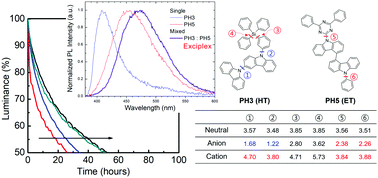Bicarbazole-triazine hybrid type mixed host materials for blue phosphorescent OLEDs with enhanced efficiency and lifetime†
Abstract
Organic light-emitting diodes (OLEDs) have emerged as mainstream displays in the small mobile display market and expanded their applications to large-sized as well as flexible displays. However, one of the main reasons for the slow expansion of OLEDs into new fields is the poor operational lifetime of the blue phosphorescent pixel. Here, we developed a series of four different p-type blue host molecules and an n-type host molecule to achieve blue phosphorescent OLEDs (PhOLEDs) with a long operational lifetime and high efficiency. With different substitutional positions of carbazole and triphenyl-silyl groups, we effectively control the photophysical- and charge transport behaviors and binding dissociation energies of the molecules. Using the combination of one of four p-type hosts and an n-type host, we properly controlled the charge carrier balance and reduced the trapped polarons in the emitting layer under electrical operation. As a result, we realized high-performance blue PhOLEDs, showing a maximum external quantum efficiency (EQE) of 20.1%, a low-efficiency roll-off (13.3% of EQE at 10 000 cd m−2), and an operational lifetime of 51 hours (T50 at 500 cd m−2).



 Please wait while we load your content...
Please wait while we load your content...